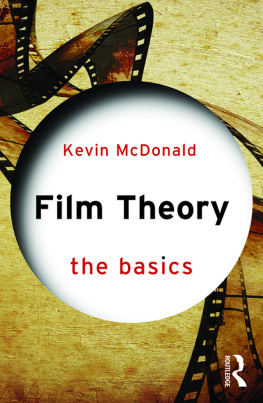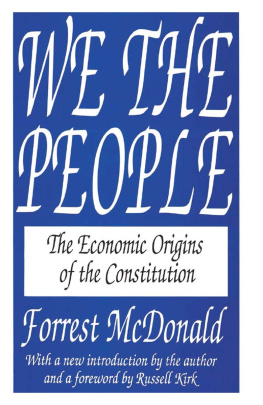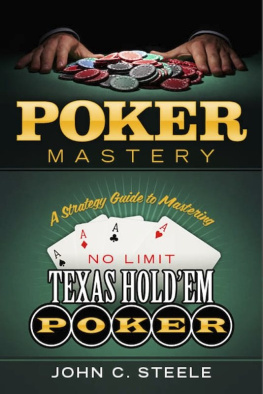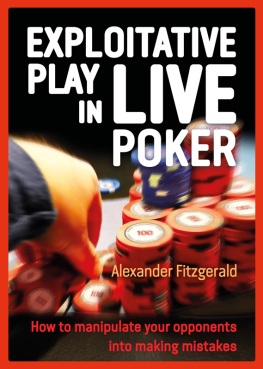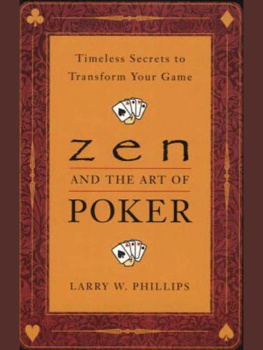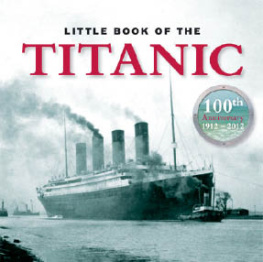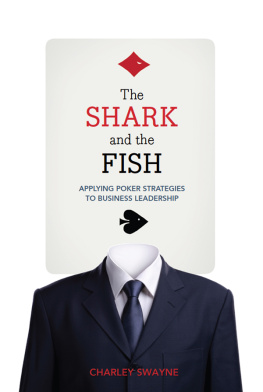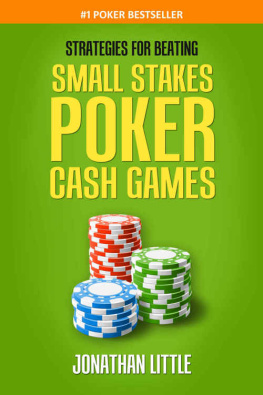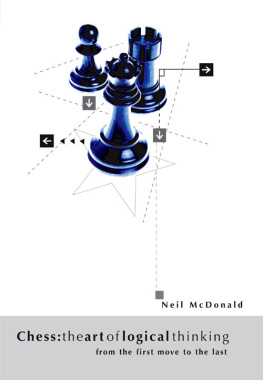
STRATEGY
IN POKER,
BUSINESS
&
WAR
JOHN MCDONALD

W. W. NORTON & COMPANY
NEW YORK LONDON
TO
OUR WIVES, POOR WRETCHES
I doubt that the mathematician, John von Neumann, and the economist, Oskar Morgenstern, will ever quite recover from their surprise and apprehension at finding a journalist after them with a manuscript concerning their rigorous and abstract mathematical Theory of Games and Economic Behavior, published a few years ago by the Princeton University Press, and theretofore studied only by the mathematically learned. They made a calculation, however, took the risk in good spirit, and were hospitable. I am grateful to them for their patient discussion of many aspects of game theory.
This book began when I looked into the theory of games in connection with an article on poker (Part I of this book) which I wrote for Fortune magazine under the title, Poker, An American Game (March, 1948). Professor Ernest Nagel of Columbia University then translated verbally and discussed with me the mathematical text of the theory. Later he made valued criticisms of this study. Oswald Jacoby, the bridge champion and authority on card games, contributed a number of suggestions on the actual game of poker. From that time until after I published a second article on the subject in Fortune, called A Theory of Strategy (June, 1949), I received valuable assistance from many other distinguished individuals. My former colleague at Fortune, Professor J. K. Galbraith of Harvard University, followed the study continuously with advice on economic and editorial questions. Professor John W. Tukey, mathematician of Princeton University, read drafts of the articles and the book, and made comments and suggestions. Dr. E. W. Paxson of the Rand Corporation, Professor E. J. Gumbel of the New School for Social Research, Professor Herbert A. Simon of the Illinois Institute of Technology, W. Edward Deming of the U.S. Bureau of the Budget, and Professor Jacob Marschak of the Cowles Commission, University of Chicago, read one or another manuscript of the articles in work, and generously made criticisms and suggestions, many of which have found their way into the book. Dr. Gunnar Boe, former Norwegian representative of the U.N. Economic and Employment Commission, gave time to discussion of game theory. Ruth Miller of the Fortune staff contributed intensive research assistance on the subject of monopoly; Mia Fritsch assisted in studying the background of poker. Mary Grace, chief proofreader at Fortune, kindly put her fine-tooth comb through the text. And there are many others who have discussed with me one or another part of this work, whom I must thank in person.
The two articles on which this book is based were the property of Fortune magazine. I am grateful to the editors, and in particular to the publisher, C. D. Jackson, for turning them over to me along with the research, for book publication. I am especially indebted to the managing editor, Ralph D. Paine, who was the patron and editor of those articles.
I am, of course, alone responsible for this result.
JMcD
By courtesy of Oskar Morgenstem
Theory of Games and Economic Behavior by John von Neumann and Oskar Morgenstern, Princeton University Press, 1944, xviii & 625 pages.
Generalization of a Theorem by von Neumann Concerning Zero Sum Two-Person Games by Abraham Wald, Annals of Mathematics, Vol. 46, No. 2, April 1945, pp. 281286.
Statistical Decision Functions Which Minimize the Maximum Risk by Abraham Wald, Annals of Mathematics, Vol. 46, No. 2, April 1945, pp. 265280.
A Contribution to von Neumanns Theory of Games by I. Kaplansky, Annals of Mathematics, Vol. 46, No. 3, July 1945, pp.474479.
The Theory of Economic Behavior by L. Hurwicz, American Economic Review, Vol. 35, No. 5, December 1945, pp. 909925.
On Weakly Ordered Systems by M. Richardson, Bulletin of American Mathematical Society, Vol. 52, 1946, pp. 113116.
On a Theorem of von Neumann by L. H. Loomis, Proceedings, National Acedemy, Vol. 32, 1946, pp. 213215.
Neumanns and Morgensterns Near Approach to Static Economics by J. Marschak, Journal of Political Economy, Vol. 54, No. 2, April 1946, pp. 97115.
Progresos en la Teoria Economica de la Conducta Individual by Jorge Mendez, Universidad Nacional de Colombia, Rivista Trimestial de CulturaM oderna, Vol. 7, July-August-September 1946, pp.259276.
A Revolution in Economic Theory? by C. Kaysen, The Review of Economic Studies, Vol. XIV(l), No. 35, 194647, pp. 115.
Theory of Games and Economic Behavior by John von Neumann and Oskar Morgenstern, Second Revised Edition, Princeton University Press, 1947, xviii & 641 pages.
Foundation of a General Theory of Sequential Decision Functions by Abraham Wald, Econometrica, Vol. 15, No. 4, October 1947, pp. 279313.
Su una Nuova Logica Economica by Giovanni Demaria, Giomale Degli Economisti e Annali di Economia, Anno VI (New Series), N. 1112, November-December 1947, pp 661671.
Demand Theory Reconsidered by Oskar Morgenstern, Quarterly Journal of Economics, Vol. 62, No. 2, February 1948, pp. 165201.
Poker: An American Game by John McDonald, Fortune, Vol. 37, No. 3, March 1948, pp. 128131 & 181187.
The Theory of Games by Richard Stone, Economic Journal, Vol. 58, No. 230, June 1948, pp. 185201.
The Utility Analysis of Choices Involving Risk by Milton Friedman and L. J. Savage, Journal of Political Economy, Vol. LVI, No. 4, August 1948, pp. 279304.
Some Notes on the Structure of the Duopoly Problem by Hans Brems, Nordisk Tidsskrift for Teknisk konomi, Nos. 14, 1948.
Theory of Games and Economic Behaviour by G. Leunbach, Nordisk Tidsskrift for Teknisk konomi, Nos. 14, 1948.
Oligopoly, Monopolistic Competition, and the Theory of Games by Oskar Morgenstern, Procedings, American Economic Review, Vol. 38, 1948, pp. 1018.
Wirtschaftshandlungen und Spielstrategie by Otto Weinberger, Statistische Vierteljahresschrift, Band II, Heft I, Jahrgang 1949, pp. 2431.
The Theory of Games by Oskar Morgenstern, Scientific American, Vol. 180, No. 5, May 1949, pp. 2225.
Theorie des Spiels by Oskar Morgenstern, Die Amerikanische Rundschau, Vol. 5, August-Spetember 1949, pp. 7687, (Translation of paper from Scientific American, Vol. 180, No. 5, May 1949, pp. 2225.)
Symposium on the Theory of Games (Madison, Wise., September 1948) Econometrica, Vol. 17, No. 1, January 1949.
Recent Developments in the Mathematical Theory of Games by E. W. Paxson, pp. 7273.
A Problem in Strategy by John W. Tukey, p. 73.
Programming in a Linear Structure by George B. Dantzig, pp. 7374.
Theorie der Glcksspiele und konomisches Verhalten by Oskar Anderson, Schweizerishe Zeitschrift fur Volkswirtschaft und Statistik, 85. Jahrgang, Nr. 1, February 1949, pp. 4653.
La Theorie des Jeux-Contributions Critiques la Theorie de la Valeur by Georges Th. Guilbaud, Economique Applique, Vol. 2, No. 2, Avril-Juin 1949, pp. 275319.
Speltieri och Ekonomiska Problem by Erik Ruist, Economisk Tidskrift, Arg. II Nr. 2, Juni 1949, pp. 112117.
The Theory of Strategy by John McDonald, Fortune, June
1949 pp. 100110.
Bayes and Minimax Solutions of Sequential Decision Problems by K. J. Arrow, D. Blackwell and M. A. Girschick, Econometrica, Vol. 17, No. 3 & 4, July-October 1949, pp. 213244.
Next page

